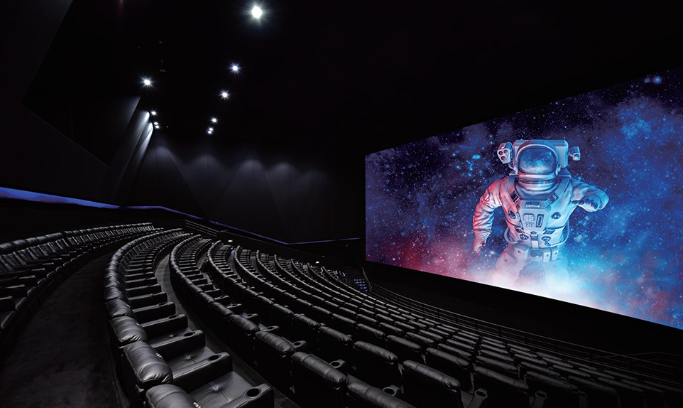Most people would choose to watch popular movies in a cinema. LED cinema display, as a new emerging option for film screening, is gradually walking into cinemas and attracting great attention among movie lovers. Unlike traditional projection screens, either a film projectors or a modern digital projector, an LED cinema display utilize LEDs to directly display images and videos on the screen itself rather than projecting images for a film reel or digital files onto the screen. This offers great advantage over image qualities and screen brightness for LED cinema displays. Some people believe that LED cinema displays will eventually take up the market of movie theaters. Let’s dive into the details and learn more about LED cinema displays, and see why people have deep belief in this new technology.

The World’s First DCI-Certified Micro LED Cinema Display
Traditionally, cinemas have used two primary display technologies: film projectors and digital projectors. Here’s a brief overview of these traditional display technologies in cinemas:
Film Projectors:
Film projectors have been the long-standing traditional technology for movie projection in cinemas. This involves using a reel of film, typically 35mm or 70mm in width, which is mechanically transported through a projector system. The film reel contains individual frames of the movie, and the projector shines light through these frames onto a large screen, creating a moving image. Film projectors provide a unique cinematic experience and have been the dominant technology in cinemas for many decades.
Digital Projectors:
With the advancement of digital technology, cinemas have transitioned from film projectors to digital projectors. Digital projectors use digital files instead of physical film reels to project movies. The digital content is stored and played from a dedicated server or media player. The projector projects the digital image onto the cinema screen, typically using Digital Cinema Initiatives (DCI) standards for high-quality digital projection. Digital projectors provide improved image quality, consistency, and ease of distribution compared to film projectors. They also offer the flexibility to showcase alternative content such as live events, 3D movies, and high-frame-rate films.
Digital projection technology has become the industry standard in modern cinemas, gradually replacing film projectors. The transition to digital projection has brought benefits such as improved image quality, easier content distribution, and the ability to support new formats and technologies. However, it’s worth noting that there may still be some cinemas that continue to use film projectors, particularly for special screenings or in smaller, independent theaters that cater to a niche audience.
An LED cinema display refers to a large-scale display system that utilizes LED (Light-Emitting Diode) technology to create the visuals for cinema viewing. These displays are specifically designed for cinema environments and are used as an alternative to traditional projection systems.
LED cinema displays consist of an array of LED modules that emit light and produce the images. The LED modules are typically arranged in a grid pattern, forming a seamless display surface. The display can be customized to various sizes and aspect ratios, allowing for flexible installations in cinema auditoriums.
LED cinema displays offer several advantages over traditional projection systems:
Image Quality:
LED displays provide high brightness levels, vibrant colors, and excellent contrast ratios. They can produce vivid and sharp images, enhancing the visual experience for moviegoers. LED technology allows for precise control over brightness and color reproduction, resulting in accurate and consistent visuals.
Scalability:
LED cinema displays can be manufactured in various sizes, from smaller screens to large-format displays. This scalability allows for customization based on the cinema auditorium’s size and seating capacity. LED displays can also be easily expanded or reduced in size by adding or removing LED modules, providing flexibility for different screening environments.
Durability and Reliability:
LED modules are known for their durability and long lifespan. They are resistant to shocks, vibrations, and temperature variations, making them suitable for continuous operation in cinema settings. LED displays also have a low failure rate, reducing the risk of technical issues during screenings.
Energy Efficiency:
LED technology is known for its energy efficiency compared to traditional projection systems. LED cinema displays consume less power while maintaining high brightness levels, resulting in reduced energy costs and environmental impact.
Customization and Design Flexibility:
LED displays offer design flexibility, allowing for creative and visually appealing installations. They can be curved or shaped to fit non-standard screen configurations, providing immersive viewing experiences. LED displays also support high-resolution content and can handle advanced features such as HDR (High Dynamic Range) and high frame rates.
LED cinema displays are gaining popularity in the industry due to their superior image quality, flexibility, and long-term cost-effectiveness. They are particularly favored for large-format screens, premium theater experiences, and installations where visual impact and immersive viewing are paramount.
LEDs contribute the most for the image quality of an LED cinema displays. LEDs complying with DCI-P3 standard ensure much richer colors than traditional LED. This means more accurate color display and rich details of an LED cinema display. That’s why LED cinema displays utilizing this kind of LEDs become a standard in the cinema display industry.
Kinglight offers various LEDs for cinema displays that offer over 99% P3 color gamut coverage and comply with the international DCI-P3 color gamut standard.

Kinglight P3 Color Gamut Series LEDs for LED cinema displays